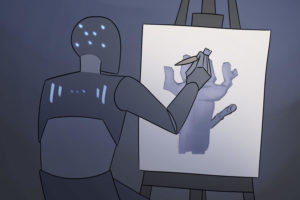February 16, 2023
“Beauty is in the eye of the beholder.” This phrase is often used to express the difference in the value of different things to varying individuals; more commonly than not, art. Art is traditionally thought of as the physical expression of ideas, emotions and creativity. Yet with the emergence of artificial intelligence technology, new forms of artwork have become possible.
To preface this opinion, one must define what artificial intelligence actually is. In short, artificial intelligence uses computer systems to mimic the critical thinking and decision-making abilities of the human brain.
AI art is art that is created entirely by algorithms. Although it is disavowed by some, from its potential to increase access to art, to its ability to open up new opportunities for collaborative artwork, there are various benefits that AI art can provide.
AI has proven time and time again that it has the potential to revolutionize the creative arts industry: improving productivity for artists and unifying art collections at a global scale. Recently, an AI medium called the AI Ark project has launched.
This is a large-scale database aimed to archive and consolidate unique pieces of art from around the world. The program has provided insight into the future for many artists as well as allowed the creation of new art forms entirely.
AI art has led to the invention of a new form of dynamic art to interact with its users concurrently, creating a truly spirited art experience. Additionally, certain programs allow artists to input their personal work so that artists with their own styles can integrate them into this new frontier of art.
AI programs are not only used to create works of art, but they can be used to evaluate existing pieces. AI can analyze the elements in an artwork such as a famous painting’s brush strokes, layout or melody to aid in its evaluation.
By using AI for creative works, artists can come up with innovative ideas with quicker turnaround times, giving them newfound opportunities to explore their creative boundaries.
However, a majority of the debate on AI art does not stem from its practicality but rather its ethicality. The ethical implications of AI art using the work of others without their consent is a complex issue.
On one hand, AI art can be seen as a form of creative expression, and as such we should allow ourselves to draw inspiration from the work of others. On the other, it is important to respect the rights of the original artists and ensure that their work is not used without their permission.
Ethical considerations for AI art that uses the work of others without their consent vary depending on the context. When using AI art for commercial purposes, I say it is important to obtain permission from the original artist before using the work. This ensures that artists are compensated for their work and their rights are respected.
In spite of that, if you use AI Art for non-commercial purposes, it may be more acceptable to use someone else’s work without their consent for inspiration or to put it in a database. In this case, it is important to ensure that the original artist’s copyright is recognized and that their rights are respected.
AI art can be used to create unique and interactive experiences, allowing people to engage with art in ways they may not have been able to do before. Therefore, AI art is a powerful tool that can and should be utilized.













